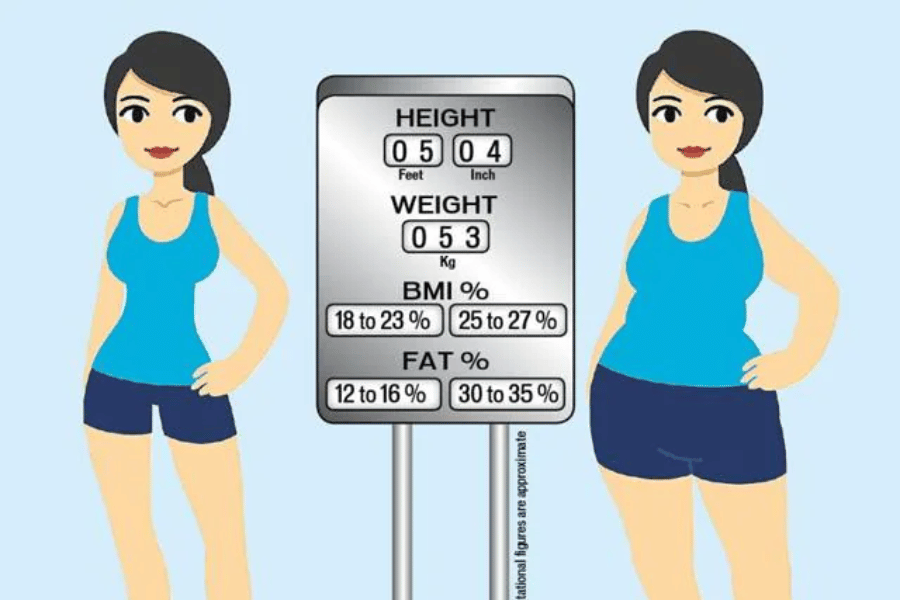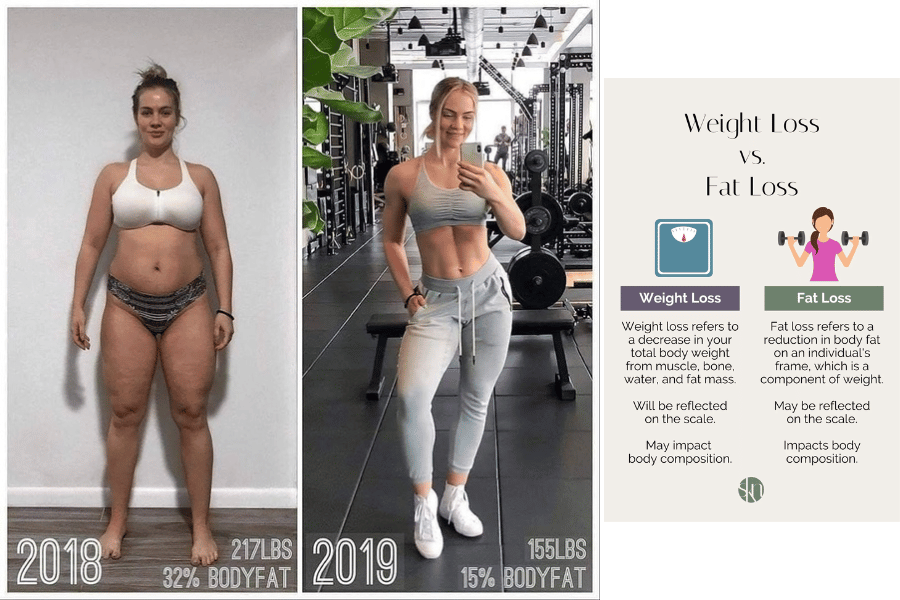Difference Between Weight Loss and Fat Loss?In our pursuit of a healthier and more confident self, the concepts of weight loss and fat loss often take center stage. However, in 2024’s guide, we’ll illuminate the critical distinctions between these two terms and why grasping these differences is pivotal on your journey to a better you.
While the quest for shedding pounds and achieving a leaner physique is commendable, understanding the disparity between weight loss and fat loss is paramount. To navigate this journey effectively, we’ll explore three key metrics that will serve as your compass, ensuring you stay on the path towards your fitness goals.
Prepare to embark on a voyage of knowledge that will equip you with the insights needed to make informed decisions, set realistic expectations, and achieve sustainable transformations. Let’s begin by unraveling the complexity of weight loss and fat loss, one layer at a time.

Weight Loss vs. Fat Loss: Understanding the Basics
To embark on our journey of discerning the difference between weight loss and fat loss, we must first comprehend the fundamental definitions of these terms.
Weight Loss is a term commonly used to describe the reduction in overall body mass. It encompasses any decrease in the numerical value displayed on your scale. This reduction can result from various factors, including the loss of body fat, muscle tissue, water weight, or even bone density. In essence, weight loss is a quantitative measure that signifies a reduction in your total body mass.
Fat Loss, on the other hand, refers specifically to the reduction of body fat percentage. Unlike weight loss, which can be a mixed bag of changes, fat loss is a qualitative measure that targets the decrease of adipose tissue, the fat that accumulates beneath the skin and around vital organs. Achieving fat loss implies a healthier body composition with a lower percentage of body fat relative to muscle mass.
It’s crucial to recognize that these terms are often used interchangeably, which can lead to confusion. While shedding weight may provide immediate gratification by showing a lower number on the scale, understanding the distinction between weight loss and fat loss is vital for several reasons.
Firstly, focusing solely on weight loss can be deceptive, as it doesn’t account for changes in body composition. Losing muscle mass or water weight may give the illusion of progress, but it can have adverse effects on your metabolic rate and overall health.
Secondly, distinguishing between the two helps you set realistic fitness goals. Your aim should be to preserve or increase lean muscle mass while reducing body fat. This not only contributes to a more toned appearance but also boosts your metabolism, aiding in long-term weight management.
Lastly, recognizing the distinction between weight loss and fat loss empowers you to make informed decisions regarding your fitness journey. Whether you’re pursuing fat loss, muscle gain, or overall well-being, knowing the difference ensures that your efforts align with your objectives.
Now that we’ve laid the groundwork, it’s time to delve deeper into the metrics that will guide you on this transformative path.

Metric 1 – Scale Weight
Scale Weight: Measuring More Than You Think
In-depth explanation of scale weight as a common metric for measuring progress.
When embarking on a fitness journey, it’s natural to gravitate towards the bathroom scale as a quick and accessible measure of progress. Scale weight, or simply “weight,” is a numerical representation of your total body mass. While it’s a straightforward and widely used metric, it’s essential to understand its nuances and limitations.
The Limitations of Scale Weight
Scale weight, although convenient, has its drawbacks when it comes to assessing your fitness journey accurately. One significant limitation is that it doesn’t differentiate between the various components that constitute your body mass. It doesn’t discern between fat, muscle, bone density, or water weight. As a result, several factors can lead to fluctuations in scale weight that may not necessarily reflect changes in body fat.
For instance, temporary fluctuations in water retention due to factors like sodium intake, hormonal changes, or even the timing of your last meal can cause your weight to fluctuate throughout the day. These fluctuations can be misleading and discouraging, especially if you’ve been diligently following a fitness regimen.
Effectively Using Scale Weight as a Tracking Tool
While scale weight can be misleading, it can still be a valuable tool for tracking progress if used judiciously. Here are some tips on how to use it effectively:
- Consistency is Key: Weigh yourself at the same time of day, preferably in the morning after waking up and using the restroom. This helps minimize daily fluctuations.
- Focus on Trends: Rather than fixating on daily changes, pay attention to long-term trends over weeks or months. This provides a more accurate picture of your progress.
- Combine with Other Metrics: To get a comprehensive view of your fitness journey, combine scale weight with other metrics like body composition and health markers, which we’ll explore in the following sections.
While scale weight is a common metric for measuring progress, it should not be the sole determinant of your fitness success. Understanding its limitations and using it in conjunction with other metrics will provide a more accurate assessment of your journey toward a healthier you.
Metric 2 – Body Composition
Unlocking the Power of Body Composition
Introduction to body composition as a more accurate metric.
While scale weight provides a general overview of your body’s mass, it falls short in giving you a precise understanding of your physical transformation. This is where the concept of body composition comes into play. Body composition delves deeper, offering insights into the specific components that make up your body, such as muscle, fat, bone, and water. It’s considered a more accurate metric for assessing your fitness progress.
Measuring Body Composition
There are several methods available to measure body composition, each with its level of accuracy and complexity. Here are some common methods:
- BMI (Body Mass Index): BMI is a simple and widely used method that calculates your body fat based on your height and weight. While it’s easy to calculate, it has limitations as it doesn’t differentiate between muscle and fat.
- Skinfold Measurements: This method involves using calipers to measure the thickness of skinfold at various body locations. The measurements are then used to estimate body fat percentage. It’s more accurate than BMI but still has some variability based on the skill of the person performing the measurements.
- DEXA (Dual-Energy X-Ray Absorptiometry) Scan: Considered one of the most accurate methods, DEXA uses X-rays to measure bone density, muscle mass, and fat mass. It provides a detailed and precise assessment of body composition.
Significance of Muscle Mass and Body Fat Percentage
Understanding body composition goes beyond aesthetics; it’s about optimizing your health and fitness. Two key components of body composition are muscle mass and body fat percentage.
- Muscle Mass: Building and preserving muscle is crucial for overall health. Muscle tissue is metabolically active and can help boost your metabolism. It also plays a role in maintaining strength, balance, and mobility.
- Body Fat Percentage: Keeping an eye on your body fat percentage is essential for managing overall health. Excess body fat, especially visceral fat around organs, can increase the risk of various health conditions. Tracking body fat percentage can help you make informed decisions about your nutrition and exercise routines.
When it comes to fitness goals, body composition provides a clearer picture of progress. It’s possible to lose weight on the scale while simultaneously losing valuable muscle mass. Conversely, you might be building muscle while seeing the scale remain relatively stable due to fat loss. Body composition measurements can help you identify these changes accurately.

Metric 3 – Health Markers
The Comprehensive Guide to Health Markers
Beyond the physical changes associated with weight and body composition, health markers provide a comprehensive view of your well-being.
When embarking on a journey of weight and fat loss, it’s easy to become fixated on the numbers on the scale or the percentages of body fat. While these metrics are undoubtedly important, they offer only a partial glimpse into your overall well-being. To achieve holistic fitness and health, it’s essential to consider a broader spectrum of indicators, known as health markers.
Understanding Health Markers
Health markers encompass a range of measurements and values that reflect the state of your body’s internal systems. These markers are influenced by both weight loss and fat loss and provide valuable insights into your health. Here are some key health markers to monitor:
- Blood Pressure: High blood pressure (hypertension) is a significant risk factor for heart disease and stroke. Weight loss and a healthy lifestyle can contribute to maintaining or reducing blood pressure within a normal range.
- Cholesterol Levels: High levels of LDL cholesterol (often referred to as “bad” cholesterol) are associated with an increased risk of heart disease. Weight loss and dietary improvements can help lower LDL cholesterol while raising HDL cholesterol (“good” cholesterol).
- Blood Sugar: Elevated blood sugar levels can indicate prediabetes or diabetes. Losing excess body fat, especially around the abdomen, can improve insulin sensitivity and regulate blood sugar levels.
- Inflammatory Markers: Chronic inflammation is linked to various health issues, including obesity and metabolic syndrome. Weight loss and a balanced diet can reduce inflammatory markers in the body.
- Liver Function: Excess fat accumulation in the liver, known as non-alcoholic fatty liver disease (NAFLD), is prevalent in individuals with obesity. Fat loss can improve liver function and reduce the risk of NAFLD.
- Cardiovascular Health: Metrics such as heart rate variability and resting heart rate can provide insights into cardiovascular health and fitness levels.
A Holistic Approach to Well-being
Incorporating health markers into your fitness goals ensures a holistic approach to well-being. It’s not just about aesthetics; it’s about fostering good health from the inside out. While weight and body composition changes are visible signs of progress, improvements in health markers signify a deeper transformation that can lead to a longer and healthier life.
That it’s essential to consult with a healthcare professional to monitor and interpret these markers accurately. They can provide guidance on tracking your health progress and making adjustments to your fitness and nutrition plans accordingly.
FAQs on Weight Loss and Fat Loss
Unlocking the Truth: FAQs on Weight Loss and Fat Loss
As we delve deeper into the world of weight loss and fat loss, it’s natural to encounter questions and misconceptions. In this FAQ section, we aim to provide clarity on some of the most common inquiries surrounding these topics:
Q1: Can you lose weight without losing fat?
A1: Yes, it’s possible to lose weight without necessarily losing fat. Weight loss can result from a reduction in muscle mass or water weight, especially in crash diets. It’s essential to focus on fat loss to achieve a healthier and more sustainable transformation.
Weight loss can manifest in various forms, but not all weight loss is created equal. Some diets or programs may lead to a reduction in overall body weight, but the composition of that weight loss matters significantly. A sustainable and health-oriented approach prioritizes fat loss while preserving muscle mass and overall well-being.
Q2: What’s the ideal rate of fat loss?
A2: The ideal rate of fat loss varies from person to person. A safe and sustainable guideline is losing 0.5 to 2 pounds (0.2 to 0.9 kilograms) of body fat per week. Rapid fat loss can lead to muscle loss and other health concerns.
There is no one-size-fits-all answer to the rate of fat loss. It’s crucial to focus on gradual, steady progress that aligns with your individual circumstances and goals. Rapid fat loss can have detrimental effects on muscle mass and metabolic health, making a balanced and patient approach the wisest choice.
Related Posts :
- En Shark Tank Products Keto Gummies Igsr
- En From The Red Carpet Royal Keto Gummies Reviews And Celebrity Slimming Methods Vlzr
- En Unlock The Power Of A 10 Minute Workout Your Ultimate Guide To Fat Loss 15no
- En Celebrity Advice On Mitigating Ketoacv Gummies Side Effects R2i8
- En Impact Keto Acv Gummies Review Zil9